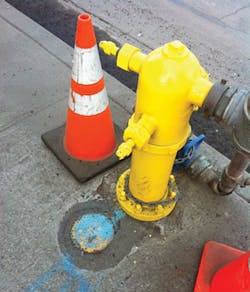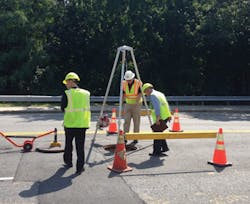By Sarah Fister Gale
The 2014 legislative environment was defined by an apparent bickering, back-stabbing and stubborn unwillingness to accomplish anything. "The general view is that it was a dysfunctional Congress where you couldn't pass anything," said Adam Krantz, managing director, government and public affairs for the National Association of Clean Water Agencies.
Despite all the ill will, one very important piece of water-related legislation managed to work its way through both the House and Senate: the bipartisan Water Infrastructure Finance and Innovation Authority program (WIFIA), which is part of the Water Resources Reform and Development Act (WRRDA). WRRDA passed with strong majorities in both Houses this past May.
What's Next for WIFIA
The passage of WRRDA was the biggest legislative success story for the water and wastewater industry in 2014, noted Tom Curtis, deputy executive director for the American Water Works Association. "Getting that legislation passed was a historic accomplishment. We all worked very hard to make it happen."
WRRDA was designed to encourage more private investment in water and wastewater infrastructure to support desperately needed maintenance and upgrades of inland waterways system, ports, channels, locks, levees, and dams in a timely and cost-efficient manner. WIFIA is a small but important part of that act.
It is a five-year pilot program that will help municipalities secure low-interest federal loans and loan guarantees to partially finance major water and wastewater infrastructure projects that are struggling to get funding. These could include drinking water systems, wastewater treatment plants, desalination plants, new water supply facilities, and levee and flood control projects.
WIFIA is modeled after the USDOT TIFIA program and includes features such as interest rates tied to long-term Treasury rates; a maximum maturity of 35 years; and limits on financing to less than 50-percent eligible project cost. However, up to 25 percent of each year's financing assistance can be made available for loans exceeding 49 percent of project cost. Municipalities would not be able to use tax-exempt debt to finance the remaining 51 percent of project costs, encouraging the use of private financing.
"WIFIA can help address financial challenges for larger projects that have trouble getting state revolving fund (SRF) loans, or they can couple SRF and WIFIA funding," said Steve Dye, consultant and legislative director for the Water Environment Federation (WEF).
There is just one problem: The WIFIA program currently has no budget. The bill authorizes $175 million be used for these projects over five years through the Environmental Protection Agency's (EPA) budget, beginning with $20 million in the first year, $25 million in the second year and so on. But the actual money has yet to be secured.
"It's not a surprise," said Tim Williams, managing director of leadership and public policy at WEF. "Appropriations always lag behind." Fortunately, $20 million is a relatively modest sum for Congress, but it still has to take that money from somewhere else to support this program, he said.
As of November, appropriations members were preparing omnibus budget legislation to fund the government for the rest of FY 2015, which could include funding for WIFIA. But if Congress chooses instead to pass another continuing resolution until the new Congress convenes in January, funding of the program will be further delayed.
Until EPA gets resources to stand up the program, it can't develop guidance or choose projects to support, Dye said. He and other industry members are confident the program will be funded; it's a just a matter of time.
UPDATE: In early December, a U.S. House-Senate conference committee approved spending legislation for the 2015 fiscal year that includes $2.2 million in funding to set up the WIFIA program. It does not, however, include funding for project loans. On Dec. 16, the omnibus appropriations bill was signed by President Obama.
Legislating Ditches and Power Plants
When it comes to other water legislation news, however, the industry is less optimistic. In particular, EPA proposed two rules in 2014 that have the potential to directly impact the water and wastewater industry.
The first is a proposed rule changing the Definition of Waters of the U.S. (WOTUS), which is a concern for many utilities because it will put new tributaries, wetlands and other waters under EPA's jurisdiction. This includes some ditches and intermittent waterways that may only run a few weeks per year, Curtis said. "That means if a water conveyance structure crosses one of these waterways, they will need EPA permits for any maintenance activities." That adds time and cost to these already expensive projects. The final definition on this rule is likely to be released in late 2015 or in 2016.
The second is EPA's proposed rule to cut carbon pollution from power plants, which it proposed in June. The proposal is designed to maintain an affordable, reliable energy system, while cutting pollution and protecting our health and environment now and for future generations. While the rule does not directly impact water systems, the water sector is one of the biggest consumers of electricity in a community, and this bill will likely drive energy costs up, Curtis said. However, it also creates opportunities for utilities to partner with the energy sector on projects to lower their own emissions and improve the energy efficiency of their water systems.
"These partnership projects can help the power plants meet their emissions targets and help utilities lower their energy costs, so it's a win-win situation," he said. However, it requires utility and energy sector leaders to be innovative and to support cross-industry collaborations that will deliver mutual benefits. This rule is expected to be finalized in 2015.
Curtis cautions utilities to take a wait-and-see attitude about these bills, given that there are big questions as to whether either new rule will survive the new Republican-led Congress. "Both bills are deeply unpopular with Republicans," he said.
UPDATE: The FY 2015 appropriations bill requires EPA and the Corps of Engineers to withdraw their Interpretive Rule issued last March, which was an attempt to clarify certain Clean Water Act jurisdictions. While this does not block EPA's larger WOTUS efforts, opponents of the rule say it is an important first step.
Made in America?
Another bill causing concern in the industry is the new requirement to use American-made iron and steel products on SRF projects, which was enacted this year as part of the Consolidated Appropriations Act of 2014. On the surface, utilities buying American-made steel products with taxpayer dollars sounds like a good idea, said Vanessa Leiby, executive director of the Water and Wastewater Equipment Manufacturers Association (WWEMA). "But it has huge implications for higher costs, supply chain issues and trade negotiations."
To comply with this rule, no single element of an iron or steel product could be produced outside of the US. This includes taking American products outside of the country for assembly and bringing them back, she explains. As a result, very few products meet the requirements, which reduces selection options for project planners and dramatically raises costs. Research conducted by WWEMA shows that project bids compliant with the American-made rule are up to four times more expensive than non-compliant bids.
WWEMA is also concerned that utilities will start requiring all projects to comply with the rule in case some federal funding is added to the budget in the future. Leiby is hopeful, however, that the rule will not be continued in the 2015 appropriations bill. In the meantime, her team is working to educate the new Congress about the negative impact of the rule.
UPDATE: The FY 2015 omnibus appropriations bill signed on Dec. 16 includes language requiring American iron and steel for SRF-funded projects. Leiby said WWEMA will continue its efforts to educate Congress in the new year.
We Can't Fix It If We Can't Afford it
Affordability is another big issue of concern for many industry groups. Neither the past nor current Congress has done much to address EPA's affordability guidance in the Clean Water Act (CWA), which states that if the cost of a clean water mandate is less than 2 percent of the median income of the community, it is affordable.
That might have been applicable when the guidance was written in 1997, but the income disparities in today's economy mean that lower income families could be spending 6 to 8 percent of their income on water, Curtis said. "For the bottom quartile of the community, that is absolutely unaffordable."
Curtis isn't arguing that clean water mandates should be ignored by these communities; rather, EPA needs to identify solutions that help communities reasonably cover the cost of these projects. One possible solution is the Clean Water Affordability Act, introduced in January 2014, to ensure that communities have the flexibility they need to undertake clean water projects in a more affordable manner.
The legislation aims to help all communities meet their regulatory obligations under the CWA in a more sustainable manner and requires EPA to provide guidance for determining a community's financial capability to support these projects.
"We need to protect the environment," Curtis said, "but we also need programs that are sensitive to the financial burdens on low-income families."
UPDATE: In late November, EPA released its new "Financial Capability Assessment Framework for Municipal Clean Water Act Requirements," which outlines socio-economic factors that will better identify what is affordable for residents and communities. Consideration of a community's Safe Drinking Water Act compliance costs is among those factors.
About the Author: Sarah Fister Gale is a freelance journalist based in Chicago, Ill. Over the last 15 years, she has researched and written dozens of articles on water management trends, wastewater treatment systems and the impact of water scarcity on businesses and municipalities around the world.
More WaterWorld Current Issue Articles
More WaterWorld Archives Issue Articles






